Miami underwent a radical transformation in the second half of the
20th century. By the early 1970s, other Latin Americans started to
make Miami their home.
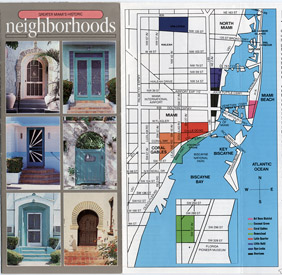 The Spanish speaking population grew by 2,000%
between 1960 and 1990, when it became the majority of the population.
Language turned out to be an important issue, both at the local level with an
ordinance passed in 1973 proclaiming then-Dade County a bilingual
community, and also in the sphere of theater, where artists and
audiences grappled with the question if plays written in a language
other than Spanish could be considered Cuban.
The Spanish speaking population grew by 2,000%
between 1960 and 1990, when it became the majority of the population.
Language turned out to be an important issue, both at the local level with an
ordinance passed in 1973 proclaiming then-Dade County a bilingual
community, and also in the sphere of theater, where artists and
audiences grappled with the question if plays written in a language
other than Spanish could be considered Cuban.
This section tells the story of how Spanish Miami, by the end of the 1970s, had evolved from being mainly a community of Cuban exiles to a cosmopolitan urban center. It articulates this growth, the pains associated with it, and the transformation of the Cuban community that survived by creating art forms that could embrace all the contradictions of human experience, in addition to those caused by the duress of exile.
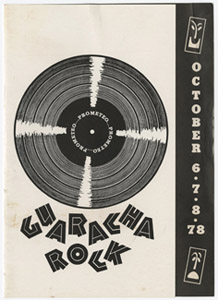 As Miami became the Cuban exile capital during the 1960s
and 1970s, two currents met on Miami's stages to enhance the
city's theatrical life. The first current saw some artists
drawing on emotions and memory to reconstruct a past they
could hardly leave behind as they tried to make sense of
the present. Whether on the island, as in the case of
Virgilio Piñera, or in exile, as with the already established
playwrights who left Cuba during the 1960s such as Julio Matas
and Matías Montes Huidobro, these writers went back to pre-revolutionary avant-garde theater.
As Miami became the Cuban exile capital during the 1960s
and 1970s, two currents met on Miami's stages to enhance the
city's theatrical life. The first current saw some artists
drawing on emotions and memory to reconstruct a past they
could hardly leave behind as they tried to make sense of
the present. Whether on the island, as in the case of
Virgilio Piñera, or in exile, as with the already established
playwrights who left Cuba during the 1960s such as Julio Matas
and Matías Montes Huidobro, these writers went back to pre-revolutionary avant-garde theater.
At the same time, another current saw a new generation of writers emerge with dramatic expressions that denoted a new Cuban-American identity, oftentimes rediscovering theater as a site of contention and reflection about the exile condition. Cuban-American dramaturgy took off, and theater directors tended to favor this theatrical expression over Cuban exile drama.
The First Exile Play
Pedro Román's Hamburgers y sirenazos (Hamburgers and Siren Blasts)
debuted in 1962 and it was staged repeatedly during the 1960s as part of the Añorada Cuba programs. It later
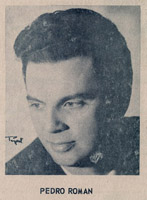 appeared in 1970's Una noche con Cuba (A Night with Cuba).
Using comedy, it was the first play written in exile to address
the plight of a Cuban family transplanted into South Florida.
In subsequent theater productions, Román moved towards the
vernacular genre with titles such as Miami es un vacilón
(con Cheo en la Comisión) (Miami is a Lot of Fun with
Cheo in the Commission).
appeared in 1970's Una noche con Cuba (A Night with Cuba).
Using comedy, it was the first play written in exile to address
the plight of a Cuban family transplanted into South Florida.
In subsequent theater productions, Román moved towards the
vernacular genre with titles such as Miami es un vacilón
(con Cheo en la Comisión) (Miami is a Lot of Fun with
Cheo in the Commission).
Keeping Cuba Alive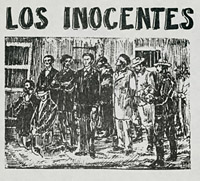 Luis Oquendo's Los Inocentes (The Innocent Ones), written by
Griselda Nogueras and Vivian García, played at the beginning
of the 1970s at the Ada Merritt School Auditorium.
Using quotes from 19th century figures such as José Martí,
Máximo Gómez, and José Sanguily, the play provided an
ideal frame to address current events in Cuba when some
segments of the exile community were losing interest
on the internal affairs of the island. The play reached
its highest dramatic moment when the voice of Pedro
Luis Boitel's mother accused the Cuban government
of her son's assassination. Boitel was a political
prisoner in Cuba who died during a prison hunger strike in 1972.
Luis Oquendo's Los Inocentes (The Innocent Ones), written by
Griselda Nogueras and Vivian García, played at the beginning
of the 1970s at the Ada Merritt School Auditorium.
Using quotes from 19th century figures such as José Martí,
Máximo Gómez, and José Sanguily, the play provided an
ideal frame to address current events in Cuba when some
segments of the exile community were losing interest
on the internal affairs of the island. The play reached
its highest dramatic moment when the voice of Pedro
Luis Boitel's mother accused the Cuban government
of her son's assassination. Boitel was a political
prisoner in Cuba who died during a prison hunger strike in 1972.
Different Voices on Stage
Tony Wagner's 1978 production of Josefina, atiende a los señores:
cuentos y cortos (Josefina, Take Care of the Gentlemen:
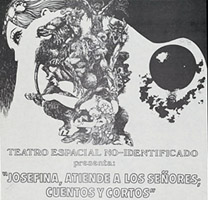 Short Stories and Fragments), put on the stage three different
voices: Pedro Ramón López who founded the exile magazine Nueva
generación; Cuban-American author Roberto G. Fernández, known
for his parodies of Miami's diasporic experience; and the
irreverent, accomplished exiled novelist Guillermo Cabrera
Infante (1929-2005). The latter's short story, which lends its title to the production,
deals with sexual exploitation of women in a patriarchal society,
Short Stories and Fragments), put on the stage three different
voices: Pedro Ramón López who founded the exile magazine Nueva
generación; Cuban-American author Roberto G. Fernández, known
for his parodies of Miami's diasporic experience; and the
irreverent, accomplished exiled novelist Guillermo Cabrera
Infante (1929-2005). The latter's short story, which lends its title to the production,
deals with sexual exploitation of women in a patriarchal society,
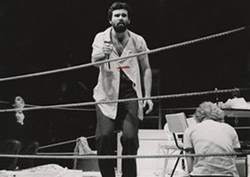 a topic rarely addressed in a milieu saturated by images
of women in equivocal situations.
a topic rarely addressed in a milieu saturated by images
of women in equivocal situations.
Night of the Assassins in Miami
José Triana's
La noche de los asesinos (Night of the Assassins, 1964) was awarded Cuba's
prestigious Casa de las Américas Prize in 1965, and it became an instant success
on the island and abroad. Tony Wagner - by then a regular in Miami's playhouses
-- brought it to Miami in 1977 and 1978 with Teatro Prometeo. His
staging placed the characters in a boxing ring to underscore the
repressive family as a microcosm of post-revolutionary Cuba. Wagner's production was followed by at least two stagings by Teatro Avante
during the 1980s, one directed by Alberto Sarraín and the other by Rolando Moreno.
 Children's Theater
Children's Theater
The first activities of the Promethean Players, as they were known in English,
included a presentation during Christmas of a famous Latin American children's story,
La Cucarachita Martina (Martina: The Tiny Bug). They performed it in Spanish in the morning
and English in the afternoon. All of Prometeo's productions were free-of-charge until 1983,
when they set their ticket price at $3.00.
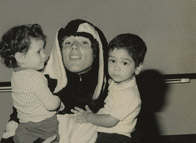 Performing Bilingualism
Performing Bilingualism
Bilingualism became an issue addressed by necessity,
especially in productions directed at younger audiences,
whose first language in many instances was already English.
One of the first bilingual plays produced in Miami was Prometeo's
Chimpete-Champata & Chi-Cheñó. With this play, they tried "to reach
a rhythm whereas the two languages would be intertwined becoming one,
but avoiding Spanglish," according to Teresa María Rojas.
The show wanted black, white, and brown hands to unite, forming
an unending dancing line, making circles led by small animals to the sounds of children's music.
Cuban-American Characters Speak
Prometeo's 1978 production of Guaracha Rock was probably one of the first instances in which Cuban-American
characters took center stage in Miami. In this "documentary" performance, Promethean Players had the opportunity to express the pain and pleasures of their adolescence, including
the use of drugs as a coping mechanism. The play used popular Cuban and American
music to underscore bicultural identities.
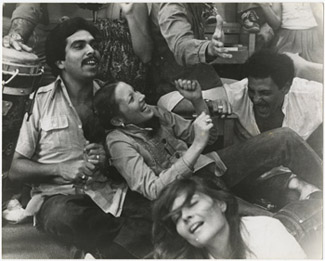

Cubans and the American Dream
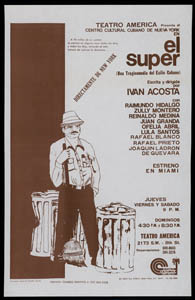 Iván Acosta' El Super (The Superintendent) also opened in Miami in 1978 after a first showing in New York City,
where it was written. New York already enjoyed the presence of notable Cuban-American
playwrights such as María Irene Fornés and Dolores Prida and exiled writers such as
José Corrales and Manuel Pereiras. In the play El Super, a father spends the northern
Iván Acosta' El Super (The Superintendent) also opened in Miami in 1978 after a first showing in New York City,
where it was written. New York already enjoyed the presence of notable Cuban-American
playwrights such as María Irene Fornés and Dolores Prida and exiled writers such as
José Corrales and Manuel Pereiras. In the play El Super, a father spends the northern
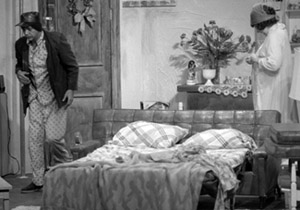 cold winter days dreaming of the warm weather of his native land, while his Americanized daughter
wants no part in his plans of going "back" to Miami. The play is one of the earliest examples
in which the American Dream is put into question on the Cuban Miami stages.
cold winter days dreaming of the warm weather of his native land, while his Americanized daughter
wants no part in his plans of going "back" to Miami. The play is one of the earliest examples
in which the American Dream is put into question on the Cuban Miami stages.
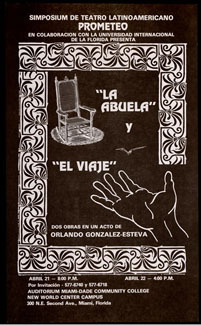 Questioning the Exile Experience
Questioning the Exile Experience
One of the earliest examples of introspection about the exile experience in
Cuban-American theater was Prometeo's 1979 production of Orlando González Esteva's La vieja
(The Old Lady) and El viaje (The Trip). La vieja visited the figure of the grandmother who
traditionally is seen as the central pillar of the home. El viaje, according to Gloria Waldman,
"revives the protagonist's departure from Cuba when he was 12 years-old, lyrically calling back
the world of his childhood. The dramatic force of the piece resides in the counterpoint
established between his remembrances and the present day world" (El Nuevo Día, June 19, 1979).
The Reunion Begins
The reencuentro or reunion topic entered Cuban theater at the end of the decade,
with the initiation of dialogue between Cuban authorities and segments of the
exile community. It took off with René Alomá's A Little Something to Ease the
Pain (1979) in which a young man returns to his native city of Santiago de Cuba
to find "answers" among the relatives that stayed behind. It premiered in Toronto's
Centre Stage in 1980. Its Spanish version, Alguna cosita que alivie el sufrir,
was translated and directed by Alberto Sarraín, with its Miami premiere by Teatro Avante in 1986.
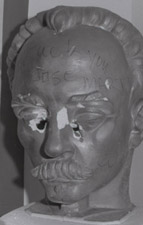 Politically, the 1970s were a time of entrenchment and militancy
among certain segments of Miami' exile population.
Direct violence
such as bombings and assassination attempts against those who
demonstrated anything but total opposition to Cuba's Castro
regime gathered momentum. While the end of the decade saw a
change in popular opinion recognizing terrorism as a stain on
the image of the Cuban exile community, a decrease in direct
violence did not mean an end to hardline reactions.
Politically, the 1970s were a time of entrenchment and militancy
among certain segments of Miami' exile population.
Direct violence
such as bombings and assassination attempts against those who
demonstrated anything but total opposition to Cuba's Castro
regime gathered momentum. While the end of the decade saw a
change in popular opinion recognizing terrorism as a stain on
the image of the Cuban exile community, a decrease in direct
violence did not mean an end to hardline reactions.
 In the theater sphere, if a work's politics were not clearly
anti-Castro or the artists' views plainly anti-communist,
hardliners staged protests and boycotts against shows deemed
controversial and used Spanish-language media to decry them.
The fact that there was a strong audience base for controversial
shows and that these acts of symbolic (and sometimes real) violence were decried
demonstrated that while the prevailing conservative voice
controlled Miami's Cuban community Spanish-language media,
it was not the only one.
In the theater sphere, if a work's politics were not clearly
anti-Castro or the artists' views plainly anti-communist,
hardliners staged protests and boycotts against shows deemed
controversial and used Spanish-language media to decry them.
The fact that there was a strong audience base for controversial
shows and that these acts of symbolic (and sometimes real) violence were decried
demonstrated that while the prevailing conservative voice
controlled Miami's Cuban community Spanish-language media,
it was not the only one.
Ñángaras (Zealots)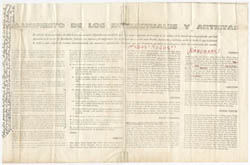 Shown here is an annotated copy of an article that appeared in the
Cuban and international press in 1960. The "Manifesto of
Intellectuals and Artists" was signed by prominent Cuban
figures and called for the revolutionary creation of a
national culture. This copy was anonymously annotated by
someone who underlined in red the names of those signatories
Shown here is an annotated copy of an article that appeared in the
Cuban and international press in 1960. The "Manifesto of
Intellectuals and Artists" was signed by prominent Cuban
figures and called for the revolutionary creation of a
national culture. This copy was anonymously annotated by
someone who underlined in red the names of those signatories
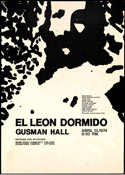 considered to be communists, such as Virgilio Piñera, Rosa Felipe,
Herberto Dumé, and Griselda Nogueras, and included the
epithets rojo (red) and ñángara (communist revolutionary zealot).
considered to be communists, such as Virgilio Piñera, Rosa Felipe,
Herberto Dumé, and Griselda Nogueras, and included the
epithets rojo (red) and ñángara (communist revolutionary zealot).
"Red Like her last name"
Prometeo's first production was Graham Greene's El león dormido (The Sleeping Lion)
in 1974. A recreation of the Faustus myth, the play had nothing to do with politics,
yet Rojas was accused of being a communist because she had chosen to stage
an author that had visited Cuba in the early 1970s.
Paper Flowers and "Red Cuba"
The U.S. premiere of Egon Wolff's Flores de papel (Paper Flowers,
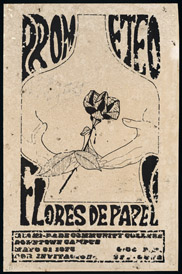
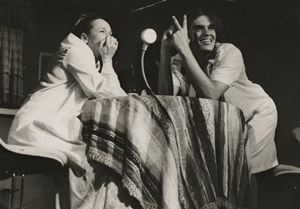 1970) by Teatro Prometeo in 1975 also caused concern in
the Cuban exile community. The play addressed the creative
and destructive forces of artistic creation, a theme of
interest to the Promethean Players. It had ample press
coverage since it was the first time Francisco Morín directed
in Miami. However, several small newspapers ran editorials
condemning the author for having accepted a prize in "Red Cuba."
A warning to then Mayor Maurice Ferré in the exile newspaper La
verdad also defamed Rojas for not being trustworthy. The publication
Libertad, on the other hand, chose this production and Francisco
Morin's direction as the best of 1975.
1970) by Teatro Prometeo in 1975 also caused concern in
the Cuban exile community. The play addressed the creative
and destructive forces of artistic creation, a theme of
interest to the Promethean Players. It had ample press
coverage since it was the first time Francisco Morín directed
in Miami. However, several small newspapers ran editorials
condemning the author for having accepted a prize in "Red Cuba."
A warning to then Mayor Maurice Ferré in the exile newspaper La
verdad also defamed Rojas for not being trustworthy. The publication
Libertad, on the other hand, chose this production and Francisco
Morin's direction as the best of 1975.
Caught in "the Cuban Thing"
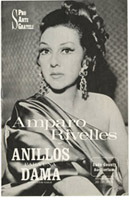 Spanish star Amparo Rivelles was involved in a controversy
for bringing about the substitution of two well-known Cuban actors in Grateli's 1975
production of Antonio Gala's Anillos para una dama (Rings for a Lady),
claming that the actors did not know their lines.
Detractors
Spanish star Amparo Rivelles was involved in a controversy
for bringing about the substitution of two well-known Cuban actors in Grateli's 1975
production of Antonio Gala's Anillos para una dama (Rings for a Lady),
claming that the actors did not know their lines.
Detractors
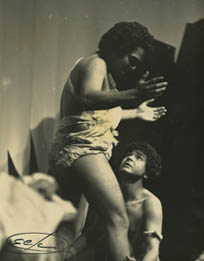 interpreted her decision and comments as being anti-exiles,
suggesting that her apparent anti-Franco stance meant she was
pro-communist. The controversy resurfaced every time the actress visited Miami.
As late as 1978, the exile publication La nación published a mock obituary
of Rivelles stating: "True Cubans do not forget the offense that you
inflicted upon us through the brilliant artists Rosa Felipe and Miguel
Angel Herrera. Do not forget that Cuba was the one that opened the
doors of America to you (August 11, 1978, p. 19)."
interpreted her decision and comments as being anti-exiles,
suggesting that her apparent anti-Franco stance meant she was
pro-communist. The controversy resurfaced every time the actress visited Miami.
As late as 1978, the exile publication La nación published a mock obituary
of Rivelles stating: "True Cubans do not forget the offense that you
inflicted upon us through the brilliant artists Rosa Felipe and Miguel
Angel Herrera. Do not forget that Cuba was the one that opened the
doors of America to you (August 11, 1978, p. 19)."
Prometheus's Unclear Message
Teatro Prometeo's 1976 staging of the play Prometeo (Prometheus), written by Tomás Fernández Travieso,
a political prisoner in Cuba, generated a paradoxical controversy. Although the play's
production meant an additional five years in prison were added to Fernández Travieso's
sentence, polemic arose because some critics believed that the play did not have a clear
political message. Others, however, wrote editorials in the Spanish press and personal
letters to Rojas commending her for the production.
No Indecency on Our Stages
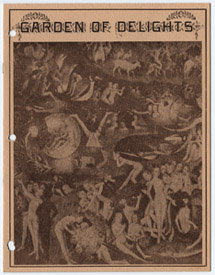
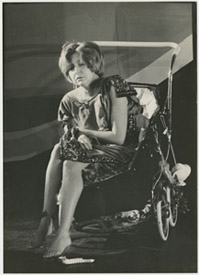 The controversy surrounding Prometeo's two stagings of
works by Fernando Arrabal during this period, Fando
and Lis in Spanish (1976) and The Garden of Delights
in English (1978), conflated issues of decency and politics.
Arrabal, an important Spanish avant-garde playwright, was
branded a communist because of his anti-Franco position.
Critics cautioned potential theatergoers against going to
see The Garden of Delights because it included elements of
bad taste. Norma Niurka, however, came to the play's defense in The
Miami News Spanish'supplement by quoting Fando's stage designer,
Siro del Castillo: "We cannot allow inquisition tribunals in
the 20th century to tell us what we can choose. When we left
Cuba, we left .. so that we COULD CHOOSE."
The controversy surrounding Prometeo's two stagings of
works by Fernando Arrabal during this period, Fando
and Lis in Spanish (1976) and The Garden of Delights
in English (1978), conflated issues of decency and politics.
Arrabal, an important Spanish avant-garde playwright, was
branded a communist because of his anti-Franco position.
Critics cautioned potential theatergoers against going to
see The Garden of Delights because it included elements of
bad taste. Norma Niurka, however, came to the play's defense in The
Miami News Spanish'supplement by quoting Fando's stage designer,
Siro del Castillo: "We cannot allow inquisition tribunals in
the 20th century to tell us what we can choose. When we left
Cuba, we left .. so that we COULD CHOOSE."
If you live in Cuba...
Francisco Morín's famous 1978 staging of Virgilio Piñera's Electra
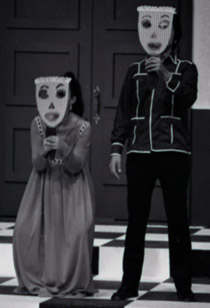 Garrigó by RAS was also blacklisted because the playwright lived in
Cuba. Although Piñera was completely ostracized in 1970s Havana,
the fact that he supposedly had not tried to emigrate made him
suspicious in some Miami circles and led to bomb threats.
The Herman Hesse quote included in the program could be read
as a commentary to the ongoing local controversy: "When
truth is threatened by struggles based on material interest and slogans . . .
then our only obligation is to save truth."
Garrigó by RAS was also blacklisted because the playwright lived in
Cuba. Although Piñera was completely ostracized in 1970s Havana,
the fact that he supposedly had not tried to emigrate made him
suspicious in some Miami circles and led to bomb threats.
The Herman Hesse quote included in the program could be read
as a commentary to the ongoing local controversy: "When
truth is threatened by struggles based on material interest and slogans . . .
then our only obligation is to save truth."
Santa Camila de La Habana Vieja
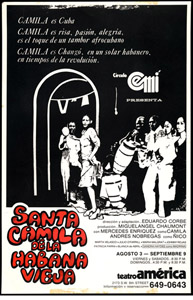
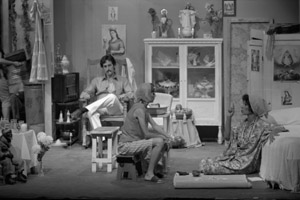 In 1979, Eduardo Corbé directed the Cuban classic Santa Camila de La
Habana Vieja by José Brene. This play premiered in Havana in 1962, and it was
one of the first plays in Miami to openly present on stage Santeria religious rituals
in a respectful manner. In spite of the importance of this production
and its success - its 40 showings were very well attended - the staging
raised debates in the city because the author resided in Cuba.
In 1979, Eduardo Corbé directed the Cuban classic Santa Camila de La
Habana Vieja by José Brene. This play premiered in Havana in 1962, and it was
one of the first plays in Miami to openly present on stage Santeria religious rituals
in a respectful manner. In spite of the importance of this production
and its success - its 40 showings were very well attended - the staging
raised debates in the city because the author resided in Cuba.
In less than
20 years, Miami became the border between Latin America
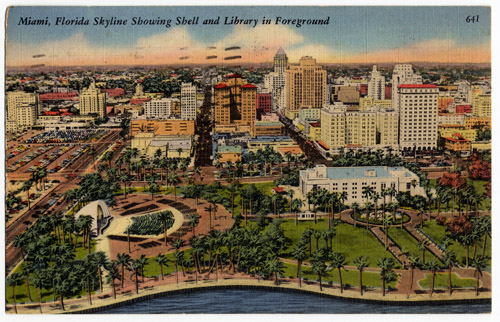 and the United States. With Hispanics accounting for 41% of the
population of Miami-Dade County in 1980. The face of Miami as the
capital of the sun was evolving. Throughout
these two decades there were scores of Cuban artists and theater
companies that thought of themselves as part of a larger international,
cosmopolitan scene. This last section tells the story of some of
those who actively participated in the cultural transformation of Miami into a world city.
and the United States. With Hispanics accounting for 41% of the
population of Miami-Dade County in 1980. The face of Miami as the
capital of the sun was evolving. Throughout
these two decades there were scores of Cuban artists and theater
companies that thought of themselves as part of a larger international,
cosmopolitan scene. This last section tells the story of some of
those who actively participated in the cultural transformation of Miami into a world city.
Manuel Ochoa's Inter-American Mission
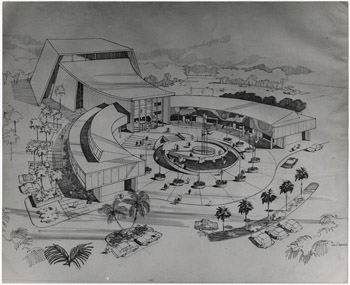 The classical musician and composer Manuel Ochoa was probably the first
exiled artist to see the artistic opportunities that Miami could offer
as the gateway to the Americas. In 1969, Ochoa created with María
Julia Casanova the Centro de Artes de América (America's Center for
the Arts).
The classical musician and composer Manuel Ochoa was probably the first
exiled artist to see the artistic opportunities that Miami could offer
as the gateway to the Americas. In 1969, Ochoa created with María
Julia Casanova the Centro de Artes de América (America's Center for
the Arts).
The Center's mission was to promote cultural friendship and collaboration among all countries from the American continent. The founding Board planned for a performing arts center that included a theater as well as schools for dance, ballet, theater and painting. Ochoa continued to pursue his inter-American ideals throughout the 1970s but his vision would finally become a reality in 1989 when he established a truly multicultural arts organization, the Miami Symphony Orchestra.
María Julia Casanova and Mujeres (The Women)
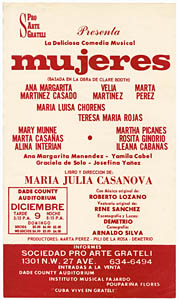 Casanova was another visionary and entrepreneur who imagined theater
in Spanish in Miami even before the 1959 wave of immigrants. She had staged
Claire Boothe Luce's The Women in Havana, a production that coincided with
the Coconut Grove Playhouse premiere of The Women in 1959. During a trip
to Miami, she met Dorothy Engle, The Women's producer and wife of George
Engle, who had bought the Coconut Grove Playhouse in 1954. Casanova had
the idea of bringing the Cuban production to Miami and staging it in
Spanish with the Coconut Grove Playhouse set. But the Cuban Revolution's
nationalization plans made her abandon the Hubert de Blanck theater she had designed and cofounded in Havana,
and in a matter of months, her life changed from a successful international
producer into a poor exile in Miami. She would have to wait till 1973 to
stage Mujeres at the Dade County Auditorium.
Casanova was another visionary and entrepreneur who imagined theater
in Spanish in Miami even before the 1959 wave of immigrants. She had staged
Claire Boothe Luce's The Women in Havana, a production that coincided with
the Coconut Grove Playhouse premiere of The Women in 1959. During a trip
to Miami, she met Dorothy Engle, The Women's producer and wife of George
Engle, who had bought the Coconut Grove Playhouse in 1954. Casanova had
the idea of bringing the Cuban production to Miami and staging it in
Spanish with the Coconut Grove Playhouse set. But the Cuban Revolution's
nationalization plans made her abandon the Hubert de Blanck theater she had designed and cofounded in Havana,
and in a matter of months, her life changed from a successful international
producer into a poor exile in Miami. She would have to wait till 1973 to
stage Mujeres at the Dade County Auditorium.
National Recognition for Grateli
By 1972, Sociedad Pro-Arte Grateli recognized Miami as a cosmopolitan center and wrote
a welcome message to its patrons in English.
Between 1974 and 1977, Grateli received four matching grants of between $10,000 and $15,000
each from the National Endowment for the Arts (NEA) through its Arts Exposure Program for
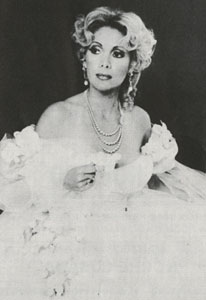 community-based arts organizations. Grateli was the first Spanish-language arts program
in Miami to receive an NEA grant.
community-based arts organizations. Grateli was the first Spanish-language arts program
in Miami to receive an NEA grant.
International Stars in Spanish-Speaking Miami
Capitalizing on the growth of Spanish-speaking communities in Miami, Grateli
expanded its repertoire to include theatrical productions and performances by
important singers and actors from the Spanish-speaking world. For example, the
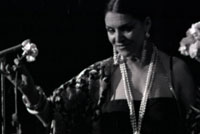 Mexican actress Jacqueline Andere played the role of Margarita in Grateli's
production of Alexandre Dumas' La dama de las camelias (The Lady of the Camellias).
Grateli also invested efforts in concerts bringing to the city major singing stars
like Rocío Jurado, Sara Montiel, and Nati Mistral.
Mexican actress Jacqueline Andere played the role of Margarita in Grateli's
production of Alexandre Dumas' La dama de las camelias (The Lady of the Camellias).
Grateli also invested efforts in concerts bringing to the city major singing stars
like Rocío Jurado, Sara Montiel, and Nati Mistral.
Repertorio Español in Miami
The New York-based theater company Repertorio Español was the first to realize that Miami
could be an important theatrical venue for its productions. Repertorio teamed up with
local companies to bring their New York productions to Miami as well as to stage
them with local actors. In 1976, with Miami architect Mario Arellano, they remodeled
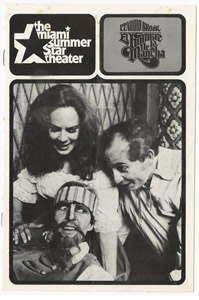 a space on Calle Ocho and opened Repertorio Español de Miami (Spanish Repertory Theater of Miami),
a 280-seat, modernly equipped theater.
a space on Calle Ocho and opened Repertorio Español de Miami (Spanish Repertory Theater of Miami),
a 280-seat, modernly equipped theater.
Man of La Mancha in Spanish
Miami was the city selected for the U.S. premiere of Man of La Mancha in
Spanish. In 1975, the Miami Summer Star Theater produced El hombre de la Mancha
with an all-star international cast, including Cuban-born performers Ana Margarita
Martínez Casado, Mario Martín, and Velia Martínez. It starred the Mexican actor
Claudio Brook, who had performed the musical on Broadway in English and in Mexico
in Spanish. The production's musical director and conductor Karen Gustafson,
was quoted in The Miami News: "The challenge of this theatrical first will be
to give Miami's Latin community an exciting and memorable musical event, while
offering English speaking audiences an experience similar to attending a foreign
language opera" (August 7, 1974, page 8A).
Spanish at the Coconut Grove Playhouse
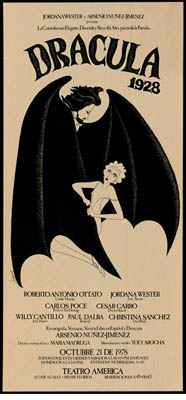 The Players State Theater, resident company of the Coconut Grove Playhouse from 1977 to 1982,
also recognized the potential in Spanish-speaking audiences. They sponsored advertisements
for their shows in a variety
of Spanish-language production programs. In 1978,
the Coconut Grove Playhouse spoke Spanish for the first time when it staged Cuban
playwright Carlos Felipe's most important play, Réquiem por Yarini
(Requiem for Yarini, 1960). Felipe was then practically an unknown playwright in Miami.
His sister, the actress Rosa Felipe, joined a cast of well-known actors in
a production that received mixed reviews.
The Players State Theater, resident company of the Coconut Grove Playhouse from 1977 to 1982,
also recognized the potential in Spanish-speaking audiences. They sponsored advertisements
for their shows in a variety
of Spanish-language production programs. In 1978,
the Coconut Grove Playhouse spoke Spanish for the first time when it staged Cuban
playwright Carlos Felipe's most important play, Réquiem por Yarini
(Requiem for Yarini, 1960). Felipe was then practically an unknown playwright in Miami.
His sister, the actress Rosa Felipe, joined a cast of well-known actors in
a production that received mixed reviews.
Miami and the Performing Arts in Spanish
Cuban and other Latin American and Latino artists began
to recognize that Miami was an ideal setting for performing
arts in Spanish. In 1978, Argentine actress Jordana Wester produced
Drácula 1928 with a cast that included actors of different Spanish-speaking nationalities.
New York-based artists started to come to Miami, bringing a new energy to the theater scene.
Famous Cuban director Herberto Dumé, for example,
moved to Miami at the end of the 1970s,
as did many other Cuban artists living abroad. Even opera stars such as Antonio
Barasorda, the renowned Puerto Rican tenor from the New York City Opera, chose to make Miami their home.
Miami Hosts Key International Theater Conference
Florida International University's Latin American Theater Symposium
in 1979 solidified Miami as an important venue for Latin American theater.
Some of the most renowned Latin American theater artists and scholars from
Latin America, Europe, and cities across the U.S. came to participate,
among them Osvaldo Dragún and Griselda Gambaro (Argentina), Isaac Chocrón (Venezuela), Carlos
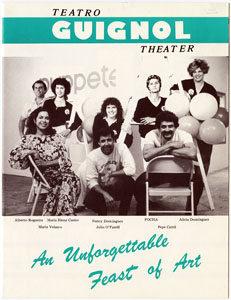 José Reyes (Colombia), Alonso Alegría (Perú), and Luis Molina (Spain).
Local artists joined these international personalities in an event that
demonstrated that Miami had become a significant center for Latin American theatrical activity.
José Reyes (Colombia), Alonso Alegría (Perú), and Luis Molina (Spain).
Local artists joined these international personalities in an event that
demonstrated that Miami had become a significant center for Latin American theatrical activity.
The Mariel Generation
In 1980, Miami and its Cuban community were dramatically transformed by the Mariel Boatlift.
Many important writers and visual artists arrived during this mass exodus that saw
as many as 125,000 Cubans arrive in South Florida in a seven-month period.
In the performing arts, this included artists like Evelio Taillacq, Zobeida Castellanos,
Pepe Carril, René Ariza and Juanita Baró. Others, like Julio Gómez and Alberto
Sarraín, came during this period from Europe. They would all become protagonists of the fruitful 1980s.
Cuban Heritage Collection
University of Miami Libraries
University of Miami, Coral Gables, Florida
Feedback